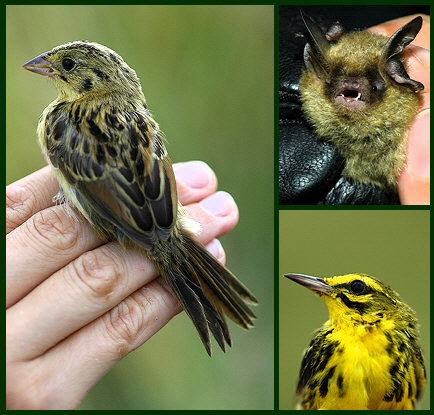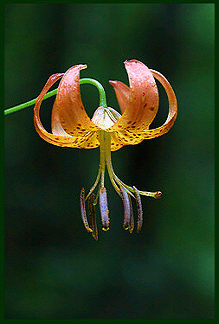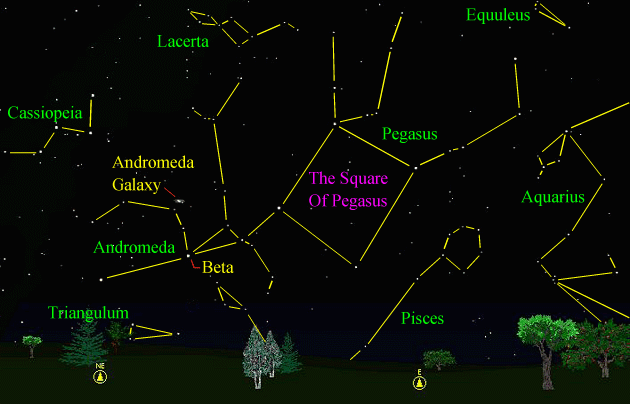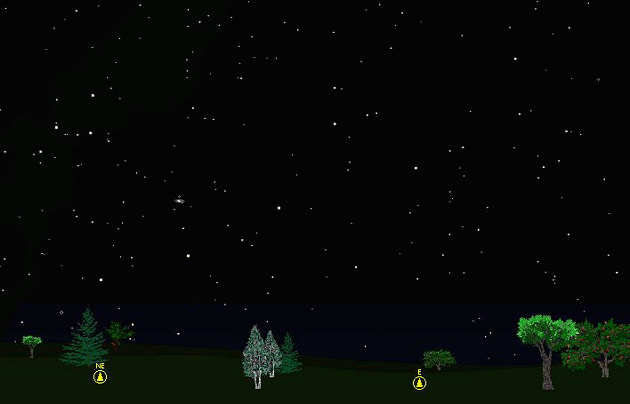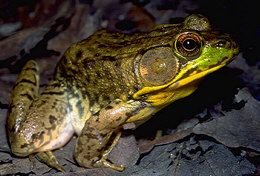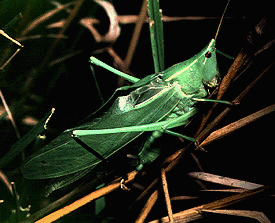The purpose of this feature is to give scout leaders, educators and naturalists an idea of some of the natural events coming up each month. We will try to cover a variety of natural events ranging from sky events to calling periods of amphibians, bird and mammal watching tips, prominent wildflowers and anything else that comes to mind. We will also note prominent constellations appearing over the eastern horizon at mid-evening each month for our area for those who would like to learn the constellations. If you have suggestions for other types of natural information you would like to see added to this calendar, let us know! Note: You can click on the hyperlinks to learn more about some of the featured items. To return to the Calendar, hit the "back" button on your browser, NOT the "back" button on the web page. All charts are available in a "printer friendly" mode, with black stars on a white background. Left clicking on each chart will take you to a printable black and white image.
Notes and Images From July 2005
In July we were part of a TWRA wildlife survey project at the Bark Camp Barrens Wildlife Management Area. Because of the sensitive nature of this grassland habitat, it is not open to the public. Bats were mist-netted and identified the first night and Henslow's Sparrows were targeted for banding the following day. One Northern Long-eared Bat was caught and released. Though the weather was a little on the warm side, a number of Henslow's Sparrows were banded and released the following day. A Prairie Warbler who wandered into the mist net was also banded. Our Cherokee, North Carolina bird and herp survey allowed us to view many beautiful wildflowers. The area had received a lot of rain in the previous few weeks, and
wildflowers were abundant. In particular, two mountain specialties, Crimson Bee Balm and Turk's-Cap Lily, flowered in great numbers along the roadsides and along our transects.
Sky Events for August 2005: Evening Sky: Venus and Jupiter shine bright in the evening twilight all month long. The two planets are the first star-like objects to become visible after sunset. Start watching for them in the west about 30 to 45 minutes after sunset. Although the two planets start out the month over 30 degrees apart, the gap between them gradually narrows throughout the month. By the end of the month they are only about 1-1/2 degrees apart, making a pretty pair. Morning Sky: The Perseid meteor shower peaks in the early morning hours of August 12th. This should be a good shower to observe, as the moon will be below the horizon during the morning hours. Up to 60 meteors an hour may be seen in dark, clear skies. There may be a temporary increase in activity around 4:00am CDT, due to the earth passing through a streamer of material shed from comet Swift-Tuttle in the year 1479. It's definitely worth checking out. The secret of having a fun meteor-watching experience is being comfortable. Get your lounge chairs, and perhaps a light blanket, ready to go the evening before (but don't set them outside, they could be soaked with dew by the time you get up). Then you can lay back and enjoy the show. A thermos of coffee or hot chocolate also is nice. The radiant (the point where the meteors appear to radiate from) is between the constellations of Cassiopeia and Perseus, so you will be looking Northeast. Mars rises about 11:00pm CDT at mid-month, and is continually growing brighter and larger in apparent size. Its disc is now about 14 seconds of an arc in diameter, so some details may be seen in good conditions with a modest sized telescope. It is closest to the earth in November of this year. After the middle of the month, start watching for Saturn and Mercury in the morning twilight. The two become easier to see as the month goes on, with Mercury reaching greatest elongation from the sun on August 24th. It also reaches its maximum brightness on that date. All times noted in the Sky Events are for Franklin, Tennessee and are Central Daylight Time. These times should be pretty close anywhere in the mid-state area. Constellations: The views below show the sky looking east at 9:50pm CDT on August 15th. The first view shows the sky with the constellation outlined and names depicted. Star and planet names are in yellow. Constellation names are in green. The second view shows the same scene without labels. New constellations this months are Pegasus, the Flying Horse, Andromeda, Princess Andromeda, Triangulum, the Triangle, Pisces, the Fishes, and Aquarius, the Water Bearer. Find the "Square of Pegasus" and work your way outward from it to the constellations around it. Look above beta Andromedae and see if you can pick out the faint glow of the Andromeda Galaxy, over 2 million light years away! City dwellers may need binoculars to pick it out. Simon Marius, in 1610, compared it's soft glow to "the light of a candle shining through horn." To get the best view, wait for it to climb higher above the horizon.
On Learning the Constellations: We advise learning a few constellations each month, and then following them through the seasons. Once you associate a particular constellation coming over the eastern horizon at a certain time of year, you may start thinking about it like an old friend, looking forward to its arrival each season. The stars in the evening scene above, for instance, will always be in the same place relative to the horizon at the same time and date each August. Of course, the planets do move slowly through the constellations, but with practice you will learn to identify them from their appearance. In particular, learn the brightest stars for they will guide you to the fainter stars. Once you can locate the more prominent constellations, you can "branch out" to other constellations around them. It may take you a little while to get a sense of scale, to translate what you see on the computer screen or what you see on the page of a book to what you see in the sky. Look for patterns, like the stars that make up the "square of Pegasus." The earth's rotation causes the constellations to appear to
move across the sky just as the sun and the moon appear to do. If you go
outside earlier than the time shown on the charts, the constellations will be
lower to the eastern horizon. If you observe later, they will have climbed
higher. As each season progresses, the earth's motion around the sun
causes the constellations to appear a little farther towards the west each
night for any given time of night. If you want to see where the
constellations in the above figures will be on September 15th at 9:50pm CDT, you
can stay up till 11:50pm CDT on August 15th and get a preview. The westward
motion of the constellations is equivalent to two hours per month. A good book to learn the constellations is H. A. Rey's
classic, The Stars, A New Way to See Them. Rey's depictions of the
constellations and witty commentary are terrific. A good general reference book on astronomy is the Peterson
Field Guide, A Field Guide to the Stars and Planets, by Pasachoff.
The book retails for around $14.00. A good beginners software program for learning the night sky
is the Starry Night Beginner program. Visit the Starry Night web site at
www.starrynight.com The program retails for around $30.00 and
contains a wealth of information.
Amphibians:
Listen for Cope's Gray Treefrogs, Gray Treefrogs, Bird-Voiced Treefrogs, Green Treefrogs and Barking Treefrogs. Northern Cricket Frogs and Southern Cricket Frogs are still calling, as are Bullfrogs and Green Frogs. Spring Peepers have a much higher, shorter call this time of year. On cooler nights listen for American Toads. After heavy rains listen for the high, insect-like call of the Eastern Narrowmouth Toad and the strange-sounding Eastern Spadefoot.
Birds: Be sure to check around ponds, river banks and on exposed mud flats for shorebirds, as many of them pass through Tennessee in August and September in their fall migration. Recommended: Bird Finding in Tennessee, Michael Lee Bierly. A classic guide to finding birds in Tennessee. The Sibley Guide to Birds, David Allen Sibley The Sibley Guide to Birds of Eastern North America, David Allen Sibley An inexpensive guide for beginners is the Golden Guide for Birds.
Insects:
Last month we talked a little about the far ranging rasps of Coneheads. The Robust Conehead has a length up to 2-3/8 inches and has a very long-lasting rasp, whereas the Nebraska Conehead has a rasp that lasts about 2 seconds. Both are common in Tennessee in August. Shown is a photo of a Robust Conehead. Note the yellow stripe down the side of the prothorax. Recommended: Songs of Crickets and Katydids of the Mid-Atlantic States, by Rannels, Hershberger and Dillon
Archives (Remember to use the back button on your browser, NOT the back button on the web page!)
Natural Calendar
February 2005
Natural Calendar
December 2004
Natural Calendar
November 2004
Natural Calendar
September 2004
Natural Calendar
February 2004
Natural Calendar
December 2003
Natural Calendar
November 2003
Natural Calendar
September 2003 Natural Calendar February 2003 Natural Calendar December 2002 Natural Calendar November 2002 Nature Notes Archives: Nature Notes was a page we published in 2001 and 2002 containing our observations about everything from the northern lights display of November 2001 to frog and salamander egg masses. Night scenes prepared with Starry Night Pro software All images and recordings © 2005 Leaps
|
